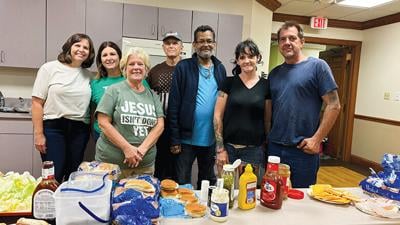A friendly, smiling Robin Freeze greeted 22 visitors who gathered Sept. 12 at the homeless ministry she founded a year ago at the First Baptist Church of Festus-Crystal City.
More than half the attendees live in an encampment east of Walmart in the Twin City area, Freeze said.
Their need for assistance and resources is at an all-time high, she said.
Officers from the Festus and Crystal City police departments went to the encampment on Sept. 10 and handed out notices informing residents that they have until Oct. 1 to move out. The notice also included a list of resources that may offer help for those who are homeless.
The tent community of about 20 people who are unhoused is precariously located on roughly 18 acres in the 70-acre ponding area of the Festus-Crystal City levee system property.
The camp is isolated on wooded bottomland hidden from view and has only well-worn paths leading to it, but it is dangerous for people to camp there due to potential flooding.
The number of people living at the encampment is believed to be at a record high.
“We’ve always had three to six homeless people around town,” Crystal City Administrator Jason Eisenbeis said. “I think they’ve lived back behind Walmart for a very long time. Since COVID, the population has grown fivefold.”
The danger of flooding was the bottom line that led officials to decide to close the camp.
“The critical moment was in July,” Festus City Administrator Greg Camp said. “The river (Mississippi) was up, and we had to close the levee gates. When the levee gates close, the ponding area is where all the water goes.
“The amount of debris that was getting sucked into the main ponding area and the levee gates was alarming. If there’s a pump failure and the ponding area starts to back up, that’s when Walmart gets under water.”
Jeremy Eck, Dam and Levee Section Safety Chief of the St. Louis District U.S. Army Corps of Engineers, said the Festus-Crystal City levee was designed to reduce the risk from a 500-year flood.
“Levees reduce the risk of flooding, but they do not eliminate the risk of flooding,” he said. “The entire population within the levee area is at risk of flooding in the event of levee failure or overtopping.”
Levee history
Festus and Crystal City jointly manage the levee system through the Operations and Maintenance Committee of the Twin City Levee Commission.
The levee, which was built by the U.S. Army Corps of Engineers after the Great Flood of 1993, was completed in 2013. It is 0.67 miles long and averages 27 feet high. Situated on the north side of Plattin Creek, it was built to keep floodwaters from the surrounding businesses and residential areas.
Once the levee was built and turned over to Festus and Crystal City, the TCLC became the Operations and Maintenance Committee, Eisenbeis said.
The committee is made up of Camp, president; Eisenbeis, vice president; Festus Public Works director Michael Christopher and Crystal City Public Works director Dan Turner. Each city has a roughly $200,000 budget to manage levee pump repairs, grass cutting, electrical and telephone expenses.
Helping the unhoused in Jefferson County
Camp said the encampment on the levee property is a complex problem with no easy solutions.
“The hardest part of this whole thing is that we are solving a much smaller problem – the protection of the levee and making sure it operates correctly,” Camp said. “The larger problem is having a comprehensive regional approach to trying to help the unhoused. We will be able to clean up the debris, but that doesn’t solve the human side.”
Freeze’s homeless ministry is addressing the human side of homelessness.
Every Thursday, from 1 to 3 p.m., Freeze and a small team of helpers provide a meal and shower services to those experiencing homelessness and those struggling financially. Huge boxes of clothing, shoes and blankets donated by church members are available, and occasionally there are sleeping bags, bicycles and tents.
Starting Sept. 19, representatives from about 10 agencies and organizations, members of the Jefferson County Coalition for the Unhoused (JCCU), will be on hand to provide assistance. A handful of agencies have attended since the beginning, Freeze said.
Those who come for help “are the sweetest people,” she said. “They are down on their luck and going through hard times. Some just come to talk because they need a friend. They range in age from their 20s to a man who is 75 years old.”
Bulmaro “Poncho” Billanueva, 25, and his wife, Karrie Miller, 26, who is five months pregnant, said they are grateful for the help they have received. They moved to Jefferson County in July from Ponchatoula, La., to escape a neighborhood plagued by drugs and to be near his relatives. They have been living in a tent by Walmart for two months.
“When we learned that Karrie was expecting, we wanted a better life,” Billanueva said.
Panhandling near Walmart has been their only source of income until recently when Billanueva was hired to work for a local landscape company.
Karla Lefarth, founder of Journey to a New Life Ministries at the First Baptist Church of House Springs, helped 27 people who are unhoused and had been living at an encampment off the Hwy. 30 corridor in High Ridge that closed in February.
“Some lost over half their stuff because they didn’t have time to get it out,” Lefarth said. “Whatever they could carry on their back or in a cart was their means of getting their things off that property. They didn’t have transportation or a way to find someplace to go.
“When we took the time to get to know these people, none of them wanted to be in the situation they were in. Most of them definitely wanted to get into housing.”
The shortage of affordable housing in Jefferson County is reflected in the high number of people trying to get U.S. Department of Housing & Urban Development (HUD) Section 8 rent vouchers.
“Currently, there are 2,205 people on the wait list for housing in Jefferson County, and 48 people with vouchers are seeking housing,” said Diana Hayes, CEO of the Jefferson-Franklin Community Action Corps.
“More than 5,000 people were on the wait list when HUD recommended that we close the list on Sept. 1, 2023. Nothing has changed. The list is still closed.”
The Jefferson County Coalition for the Unhoused began meeting about four years ago to tackle the issues related to homelessness.
“We try to not only provide things to the unhoused that help them temporarily, but also want to make sure people get the right kind of help so they no longer deal with homelessness,” said Dan Ross, pastor of New Hope Fellowship Church in High Ridge and a member of the JCCU leadership team.
“Ultimately, we need a facility to help people get out of their situation. There are limited long-term options to address the complex underlying issues that relate to an individual being unhoused.”
“People often stereotype a homeless person as someone suffering from substance use or who doesn’t want to work,” said Karen Ferrell, housing manager for Compass Health Network. “However, this is most often not the case.
“Over the past year, there has been a spike in those who are older who receive a small pension or smaller Social Security income. When rent prices began to increase, they started having to make a choice about how to spend their income. They began losing housing as their checks could no longer meet their basic needs. The same holds true for those on disability or with other types of limited income.”
Camp and Eisenbeis hope the Sept. 16 opening of the Festus Behavioral Health Crisis Center run by the Compass Health Network may bring some relief,
“This will put trained social workers, nurses and doctors directly with people who are dealing with a crisis,” Camp said. “This is a step toward bringing more assets to our community.”
Lauren Bruce, senior director of BHCC, said the facility can only provide so much help.
“Being housing displaced is a complex situation that has variables unique to each individual. Our primary role is not to solve every complex problem someone presents with but to identify and treat the acute crisis,” she said. ““Unfortunately, we may not be able to create new resources to solve challenges our housing displaced individuals face; however, we can seek to connect someone with ongoing resources and services within the community and at Compass.”
The Oct. 1 deadline is coming quickly for those living at the encampment near Walmart.
The newly married couple, Billanueva and Miller, whose baby, Isabella, is due in December, recently applied to live at a HUD Section 8 apartment.
“We’ve been through a lot,” Billanueva said. “But, you should never give up. It gets easier.”




